StoryWeaver Spotlight: Indugu Laxmi
Posted by Remya Padmadas on September 16, 2016 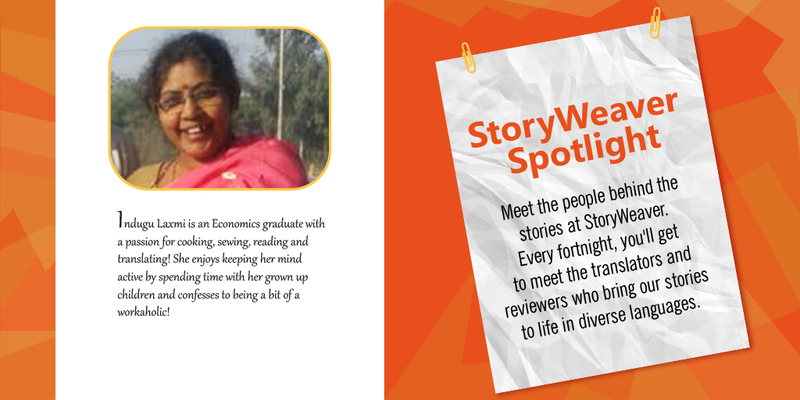
Q: What do you usually read? Which language do you prefer to read in?
A: I read whatever I get to and whatever I find interesting: from newspapers, magazines, online articles, my children's academic books to everything! I prefer to read in English the most.
Q: Do you have a favorite book / author and why is it a favorite?
A: I find no particular book or author as my favorite, I love many books, many authors and many languages.
Q: You have contributed for us immensely. How has the StoryWeaver journey been?
A: Simply GREAT! I have learnt many new things, I discovered the ability to express my thoughts in a simple manner.
Q: Could you share with us a story or anecdote from the translations / reviews? Or one big thing that you take away from this experience?
A: Not just one or two things, I have learnt so much and experienced so many things from these children books. In one of Pratham Books’ Annual Storytelling sessions in Delhi, I went to a Telugu school to conduct a Telugu story-telling session, I was apprehensive about the response of the staff and most importantly the kids with whom I was supposed to interact. But to my surprise, at the end of the session I was very emotional with tears in my eyes, I was encircled by so many small children, requesting for more stories. I was totally a stranger to them but the stories made me their favorite, the feeling was indescribable. It was a moment I will treasure all my life.
Q: How does it feel when your story gets published online?
A: Great! Because being a person of seventies and eighties, that too coming from Odisha a state, wrongly labeled as backward and poor it feels GREAT when I think I am not lagging behind with the modern time and methods, and whatever I am doing I am repaying my debt to my mother state.
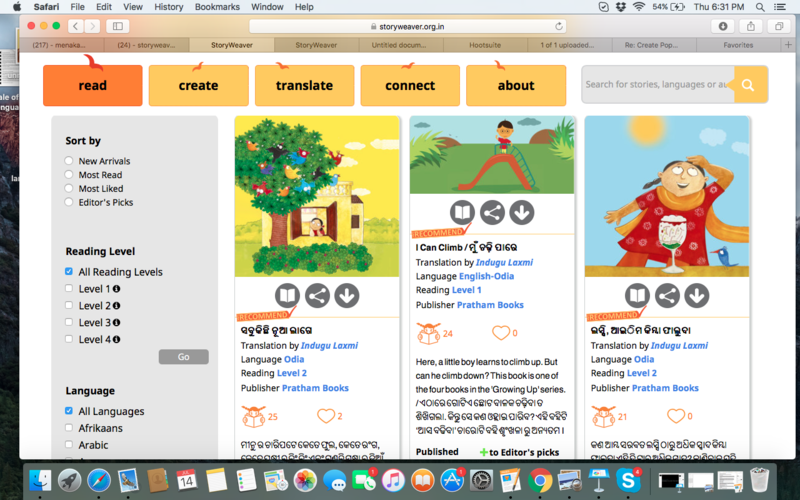
Q: You have translated / reviewed a handful of stories for us. Which one has been your favourite and why?
A: My favorite book is 'We Call Her Ba', the book is about Smt.Kasturba Gandhi. Though I had read about the freedom struggle and Gandhiji in my student days, this book took me to a period of time not familiar to me. I loved the language, narration and everything about it.
Q: What is your key driver in taking this up?
A: The driving cause is the concept of introducing children to stories of languages other than their mother tongue. The exposure to different kinds literature in one’s childhood transforms the child into a person of responsible nature, knowledgeable, and more tolerant towards other cultures which is the need of the hour at present.
Q: How else do you think we can join hands in taking bigger steps for children’s literature?
A: I feel I have no such high intelligence to offer any constructive ideas but in my small mind I feel that, in these TV addiction days it will get more attractive for children if the story telling or narrating session could be telecast on television.
Q: How has the overall experience with StoryWeaver been?
Ans. ବହୁତ ବଢ଼ିଆ , ତୃପ୍ତିକର କାମ | Very Pleasant, Highly satisfying .
Q: How did you cross the technology barrier for this?
A: Without facing much difficulty. I always want to change with times and like to keep pace with my grown up children so my children taught me everything . They encouraged me a lot and boosted my confidence. So it was smooth sailing.
To read all the wonderful translations by Indugu on SW, click here!
comments (3)StoryWeaver Spotlight: Jayant Meghani
Posted by Remya Padmadas on September 22, 2016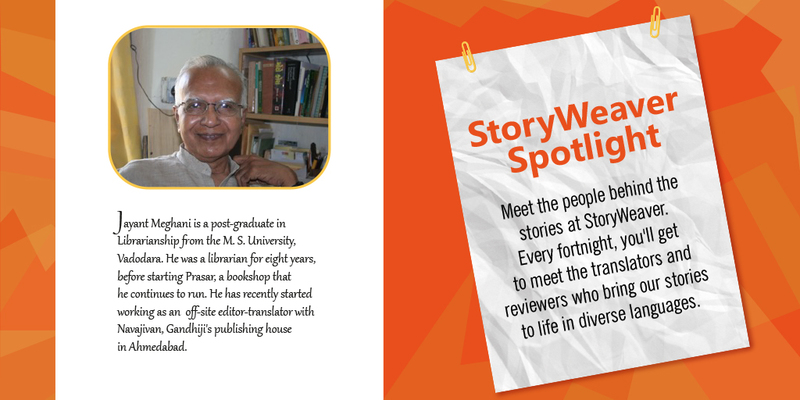
1. What do you usually read? Which language do you prefer to read in?
My meagre reading consists of stray books, normally non-fiction. My mother tongue Gujarati would be my preference, but I also like to read books and magazines in English and sometimes Hindi.
2. Is there a favourite book / author and why is it a favourite?
Nothing in particular. I like exploring a wide field when it comes to authors and subjects. I am a generalist.
3. You have contributed for us immensely. How has the StoryWeaver journey been?
I have liked the stories that I have worked on and am impressed by how educative they are.
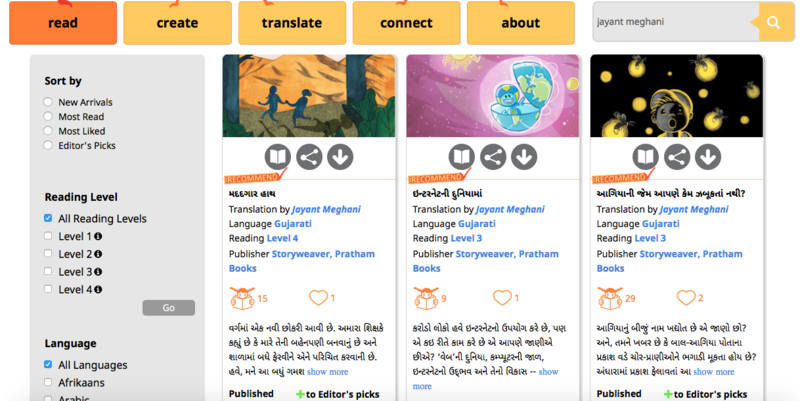
4. How does it feel when your story gets published online?
Naturally one feels satisfied having participated in an educative process. I also derive creative joy.
5. You have translated / reviewed a handful of stories for us. Which one has been your favourite and why?
I really enjoyed working with quite a few stories. One that I had particularly liked was about a cat in the Sahyadris - ‘Cat in the Ghat’.
6. What is your key driver in taking this up?
Being a bookman all my working life - now over half a century - I love to work with words, in my own language as also in English. The kind of stuff that you create is purposeful and that attracts me even when I am hard pressed for time.
7. How has your overall experience with StoryWeaver been?
પ્રથમના
બાલસાહિત્યના અનુવાદ અને સંપાદનનો મારો અનુભવ ખૂબ આનંદદાયક અને ઉત્સાહપ્રેરક રહ્યો. મને લાગ્યું કે જેમને જાણતો નથી એ તમે બધાં મિત્રો સમાન રસનાં છો, અને તમારી સાથે કામ કરવાનું મારા વ્યસ્ત નિવૃત્તિકાળમાં ઊંડો સંતોષ અને આનંદ આપનાર છે.
The experience of translation and editing with Pratham Books StoryWeaver has been delightful and stimulating. It is satisfying and joy-giving to work with you in this active dusk of life.
8. While reviewing stories, what are the top three things you keep in mind?
Any material for wider consumption amongst children should be clean and correct in the matter of language, and aesthetically healthy and of good taste. Ultimately everything should boil down to creating a better human being. Stories should be entertaining no doubt, but the element of education is of paramount importance in our developing society.
Be the first to comment.StoryWeaver Spotlight: N. Chokkan
Posted by Remya Padmadas on September 29, 2016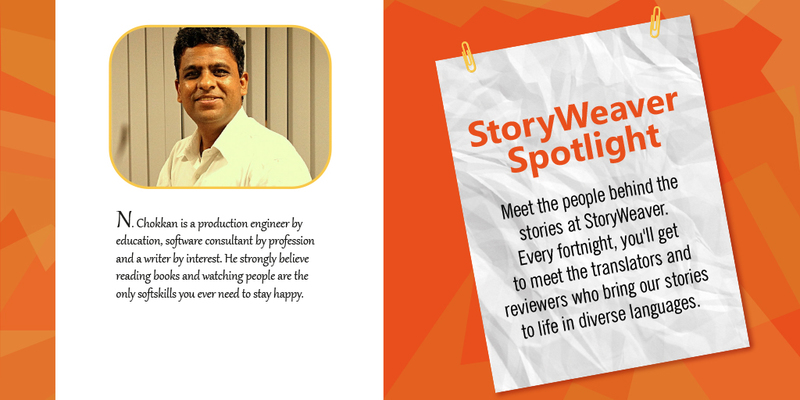
1. What do you usually read? Which language do you prefer to read in?
Like most readers, my preferences change every few years. For the previous five or six years, I am mostly reading poems (and few stories/articles) written at least few hundred years back. It is fascinating! Given a choice, I would ONLY read Tamil books :) Mainly because there is so much to read there and I am quite comfortable reading Tamil. I usually read English books for relaxation or when my work demands it.
2. Is there a favourite book / author and why is it a favourite?
Favourite book: there are many, don't want to name a single one :)
Favourite authors: J. K. Rowling in fiction, Nammazhvaar, Kambar and Bharathiar (All Tamil) in poetry, Sujatha (Tamil) in Nonfiction.
Reason: when you read just a few paragraphs from any of their work, you will immediately know that they care for their readers. I feel that is an important skill for an author.
3. You have contributed for us immensely. How has the StoryWeaver journey been?
Amazing. I loved the concept of infinite stories in different languages in a single platform. I am enjoying it!
4. Could you share one big thing that you take away from this experience?
I guess the biggest thing I learnt from StoryWeaver is that stories and images don't stop within a book.
I mean, when you read a printed picture book, you are focused on it, you complete it, close it and then you pick up the second book. A similar experience is possible with StoryWeaver too; one can read each story separately and enjoy it. But, the fun increases multifold when you look at the "picture repository". Suddenly, you see all those images at your disposal; I can mix two images from two different stories and create a third story. Someone (coming from a different background) may mix those images backwards and create a fourth story. This means you have an unlimited supply of stories, most of them may not even be written!
5. How does it feel when your story gets published online?
It doesn't create the kind of excitement I get when I see a story published in print. But then, I am not a digital native and I still love print books. So don't take this feedback personally!
6. You have translated / reviewed a handful of stories for us. Which one has been your favourite and why?
That would be "A Helping Hand" by Payal Dhar, illustrated by Vartika Sharma.
I enjoyed reading this story which talks about friendship and fitting in. It has an implicit message, even some scientific facts, but they don't disturb the story flow, which fills us with positivity.
7. What is your key driver in taking this up?
Very simple, I like writing, and I keep looking for new ways to write and learn. As I told earlier, StoryWeaver gives me unlimited options to do so.
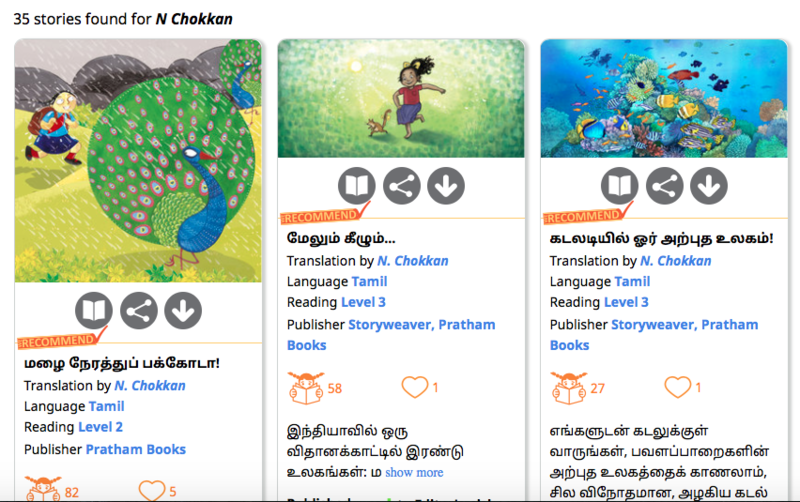
8. How else do you think we can join hands in taking bigger steps for children’s literature?
I know there are many kids' books (stories and images) which are in public domain. I feel StoryWeaver can have a crowdsourced project to bring them to its platform.
Also, given the fact that many of your target audiences may only understand their regional language (even their mother tongue) and can't read, you can think of adding the audio capability to story pages. I mean, one volunteer can read the story and hundreds of kids can listen to it, even if they can't read that language.
9. How has the overall experience with StoryWeaver been?
அருமை! ஒரு வாசகனாகவும் எழுதுகிறவன், மொழிபெயர்க்கிறவனாகவும் StoryWeaverஐ மிகவும் ரசிக்கிறேன்!
Excellent! I love using StoryWeaver as a reader and as a writer/translator!
10. What’s the secret behind your awesome professionalism?
Ah, finally an easy question :)
My teachers (in and out of school) taught me that professionalism is as important as (if not more important than) the talent. I am just trying to follow their advice. If at all I am doing well on this aspect, credits should go to them!
Be the first to comment.